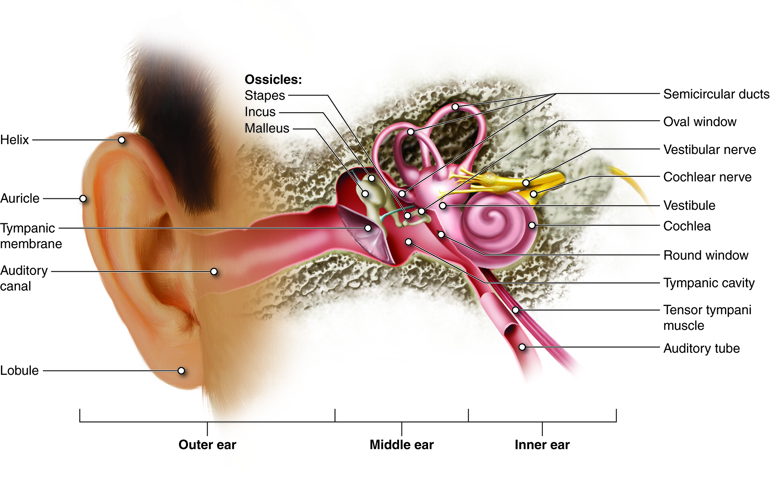Static Equilibrium Receptors Are Located in the
It is divided into two types--static and dynamic equilibrium. Where are equilibrium receptors located.

8 2 A P The Ears Flashcards Quizlet
Contained in the bony vestibule are two.

. However unique receptors in the internal ear are crucial in monitoring two types of equilibrium. See answer 1 Best Answer. Dynamic equilibrium is detected by the crista ampullaris.
Please log in or register to answer this question. The receptors for dynamic equilibrium respond to rotational forces. Dynamic equilibrium monitors angular or rotational movements of the head when the.
Receptors for static equilibrium and linear acceleration 15 utricle. The receptors for dynamic equilibrium are not stimulated by head movement. Only in the semicircular canals of the ear.
Transmission of light through the lens. In the semicircular canals and in the vestibule of the ear. In the semicircular canals in the spiral organ of Corti and in the vestibule of the ear d.
A semicircular canals B auricle pinna C cochlea D tympanic membrane E vestibule. The vestibule is the primary detector of changes in static equilibrium. Static equilibrium is detected by 6.
The sense of equilibrium responds to movements of the head. Anatomy Answer the following questions that pertain to the anatomy of the vestibular apparatus. The receptors for dynamic equilibrium are located in the vestibule of the ear.
The superior region of the nasal cavity. Stimulation of hair cells in the spiral organ of Corti b. A sensory receptor called a macula is located in the walls of the saccule and utricle the two bulblike sacs of the vestibule.
Static equilibrium receptors are located in the _____. Where are equilibrium receptors located. The information for static equilibrium and linear acceleration dynamic comes from the utricle and saccule within the vestibule.
Static equilibrium receptors are located in the _____ vestibule The bending of static equilibrium receptors is caused by _____ otoliths Dynamic equilibrium receptors are located in the ____ semicircular canals Static equilibrium is detected by _____ maculae. Static equilibrium monitors head position when the body is not moving. Static Equilibrium is the balance maintained by the sensory organs in response to movements of the body mainly the head relative to the forces of gravity acceleration deceleration.
In the semicircular canals and in the vestibule of the ear b. Only in the vestibule of the ear c. The perception of equilibrium occurs in the vestibular apparatus.
Describe and give an example of these two types of equilibrium. The receptors for dynamic equilibrium respond to rotational forces. Our sense of static equilibrium is created by the _____.
These maculae plural are oriented 90 degrees to one another so that they respond to positions in different. Static equilibrium is detected by maculae. B ampullae of the semicircular canals.
Static equilibrium receptors are located in the _____. The receptor cells for static equilibrium are located in the. Its Role in Equilibrium Answers Anatomy 1.
What are the small calcium carbonate crystals. A vestibule b cochlea c tympanic membrane d semicircular canals e auricle pinna vestibule. The saccule and utricle each contain a sense organ called the macula where stereocilia and their supporting cells are found.
The receptors for static equilibrium are located in the innerear of humans. What are the sensory receptors for static equilibrium called. The bending of dynamic equilibrium receptors is caused by the cupula.
A maculae of the utricle and saccule of the vestibule. The receptors for dynamic equilibrium respond to rotational forces. Dynamic equilibrium is detected by the semicircular canals otoliths 4.
The receptors for dynamic equilibrium are called maculae. D otolithic membrane of the utricle and saccule of the vestibule. Dynamic equilibrium receptors are located in the semicircular canals.
Contains receptors for static equilibrium 14 saccule. The receptor for rotational angular movements of the head called the __ __ is a minute elevation. Static equilibrium receptors are located in the vestibule 5.
The receptors for dynamic equilibrium are not stimulated by head movement. A ciliary b tarsal c ceruminous d lacrimal. The _____ gland is located above the lateral end of each eye and releases tears.
C spiral organ organ of Corti of the cochlea. Static equilibrium is detected by mechano-receptors found in the vestibule of the inner ear. The bending of dynamic equilibrium receptors is caused by the Reset Help.
Motion in the following two structures is detected as follows. The eyes and proprioceptors in joints tendons and muscles are important in informing the brain about equilibrium and the position and movement of body parts. Dynamic equilibrium receptors are located in the crista ampullaris 3.
Static equilibrium receptors are located in the vestibule. Where are the static equilibrium sensory receptors located two places. Static equilibrium involves the movement of the head with respect to gravitational force.

7b Static And Dynamic Equilibrium Flashcards Quizlet

Two Kinds Of Equilibrium 1 Static Equilibrium Refers To The Maintenance Of Body Head Position Relative To The Force Of Gravity 2 Dynamic Equilibrium Ppt Download

Comments
Post a Comment